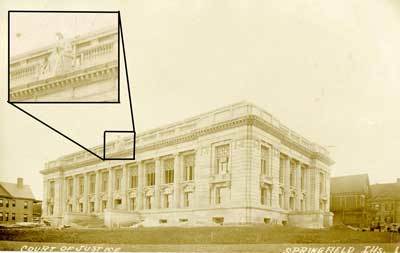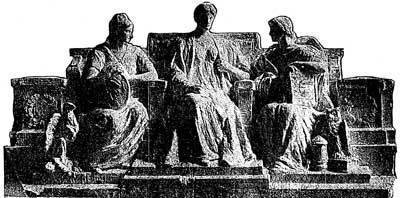December 18, 2018
 In the winter of 1907, a photograph was taken of the not-yet-completed Illinois Supreme Court Building. The resulting postcard, pictured here, shows a statue adorning the balustrade. Observers today will recognize that no such statue currently sits on the roof of the building, nor was the statue even there at the dedication of the building in February 1908. The postcard that shows the statue is the only known photograph. All subsequent photographs show no statue on the roof. What happened?
In the winter of 1907, a photograph was taken of the not-yet-completed Illinois Supreme Court Building. The resulting postcard, pictured here, shows a statue adorning the balustrade. Observers today will recognize that no such statue currently sits on the roof of the building, nor was the statue even there at the dedication of the building in February 1908. The postcard that shows the statue is the only known photograph. All subsequent photographs show no statue on the roof. What happened?
The statue was one part of an original design by Charles Mulligan, the famed Chicago sculptor, entitled “The Three Sisters” of Justice, Law, and State, also pictured here. In a Chicago Tribune article from August 1907, Mulligan was hard at work on Justice with his model, Irene McDermott. Mulligan finished the statue in September, and a short article in the Illinois State Register in October noted that the statue of “Justice” had been placed in position “surmounting the main entrance to the beautiful supreme court building.” At some point between October 1907 and February 1908, the statue had been removed, and the other two parts of the greater project, Law and State, were never installed and probably never finished.
 Weight was the most likely reason as to why the entire sculpture as planned was never completed. The architect and the construction company may have been concerned that the weight of the three statues would be too much for the roof and balustrade. “Justice” itself was more than twelve feet high and must have been extremely heavy. Rather than continue with the project, the architect decided to scrap “Justice” and the remaining “Three Sisters” altogether.
Weight was the most likely reason as to why the entire sculpture as planned was never completed. The architect and the construction company may have been concerned that the weight of the three statues would be too much for the roof and balustrade. “Justice” itself was more than twelve feet high and must have been extremely heavy. Rather than continue with the project, the architect decided to scrap “Justice” and the remaining “Three Sisters” altogether.
Mulligan changed his focus from “The Three Sisters” to a new design. A few short years later, two statues by Charles Mulligan were installed at the steps of the entrance to the Supreme Court Building: Justice and Power on the left and Law and Knowledge on the right. Those statues remain guarding the entrance this very day.
A more interesting question is what happened to “Justice.” Was it destroyed? Was it carefully removed to be remounted elsewhere? Was it chiseled up into small pieces to be given away as souvenirs? The newspapers do not provide any answers, and Mulligan died only a few years after the dedication of the Supreme Court Building with no extant writings to explain “Justice’s” disappearance. Interestingly, Mulligan’s obituary in the Chicago Tribune in 1915 gave several examples of his sculptures—one of which was the non-existent “Three Sisters.”
If you know anything about the statue that rested on the roof of the Supreme Court Building for a mere four months, please contact the Supreme Court Historic Preservation Commission at john.lupton@illinoiscourthistory.org.